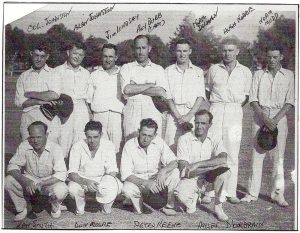A Story of Three Shields
Hanging on the wall inside the present pavilion at Lorn Park are three shields – the Irwin Shield, the O’Hearn Shield, and the Wailer Shield.
The shields are a little the worse for wear – not surprisingly so, as they were salvaged and restored after a fire burnt out the pavilion in 1981.
However, they still serve as a reminder of Northern’s success during the 1920’s and early 1930’s when the Club became permanent holders of all three shields.
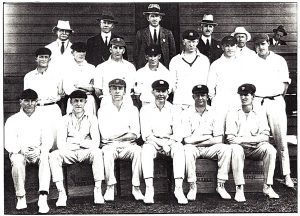
Middle row: D.E.Thrift, R.W.McClean, C.V Morrissey, H.Patfield, J.C.Long, C.Bendeich, G.Bell.
Front row: V.Cleary, S.McGlynn, Dr. E.P Barbour, W.C Johnston (Capt.), R.H Oakes, C.A Sivyer
The Irwin Shield
This shield was donated in 1921 to the Association by Con Irwin, a former leading player in the pre-war days, and was allocated as a trophy for the winner of the A Grade Final between the premiers and the runners-up. The Club winning the shield the most number of times over five seasons had the right to retain it.
The shield was won outright at the end of the 1925-26 season by Northern Division. However, the award had to be decided on averages as Northern and Branxton had each won the Shield twice during the period that it was contested (1921-1926) – Branxton in1922-23 and 1925-26; and Northern in 1923-24 and 1924-25. Robins Club had been the other winner in 1921-22 – the first season in which Finals had been played.
To decide the winner, the Association took into account the averages of Branxton and Northern over the whole five seasons. Northern came out with an average of 6.08 runs per wicket compared with Branxton’s 4.88, giving Northern a credit difference of 1.2 runs per wicket in their favour. When the calculations were being made, it was worked out that the two Clubs had met on 9 occasions with Northern scoring 2575 runs for 105 wickets at an average of 24.52, and Branxton had scored 2069 runs for 98 wickets at an average of 21.11.
During this time Branxton had a very strong team that included players such as Harold Hatcher, Charlie Bendeich, and the four Thrifts – Dan, Dave, Dick, and George.
It was probably justice that Northern Division should have won the Shield as over the five seasons the Club had been A Grade premiers or runners-up and had participated in every Final for the Irwin Shield.
It is interesting to note that some of these early Finals extended over four or five Saturdays. Matches were played out to the finish with no limit on the number of playing days. For instance, the 1922-23 Final between Northern and Branxton lasted for five Saturdays from March 31 to April 28, before Branxton eventually won the match by four wickets.
The O’Hearn Shield
This shield was donated in 1925 by the local State Member, W.F.O’Hearn, for the winner of the A Grade Premiership. Like the Irwin Shield, the Club winning it the most times over five seasons became the permanent holder.
The shield was won outright by Northern Division at the end of the 1929-30 season. During the period the Shield was contested (1925-30) Northern won two A Grade Premierships – in 1925-26 and 1929-30 – while three other Clubs each won a Premiership once – Morpeth (1926-27), Robins (1927-28), and Branxton (1928-29). Branxton again came close to edging out Northern as permanent holders of the shield, as they were just one point behind Northern in the 1929-30 competition when the final decision on the awarding of the O’Hearn Shield was made.
The Waller Shield
This shield, donated by Alderman J.H.Waller, the Mayor of the Municipality of West Maitland and a former Association Vice-President, replaced the Irwin Shield for the winner of the A Grade Final with the same five year conditions to apply.
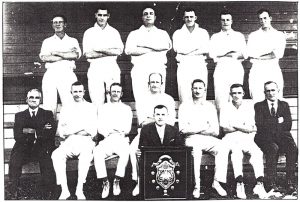
Front (Left to Right): Elias Bowden (President), C. Randall, Arthur Watson, Roy Oakes (Captain), Bruce Lindsay, Herb Patfield Senior, Claude Pearson (Secretary)
Seated: Harold Lanham (Scorer)
The Waller Shield was also won outright by Northern Division at the end of the 1930-31 season by which time the Club had won three Finals – in 1928-29~1929-30; and 1930-31- during the five seasons that the shield was contested from 1926-31. The other two Finals had been won by Robins Club in 1926-27 and 1927-28.
On the Shield next to the names of the winning Clubs appear the names of their captains – L.(Leon) Moore twice for Robins and R.(Roy) H.Oakes three times for Northern Division.
The three Finals contested by Northern were against Branxton which was still a strong Club with players of the calibre of Tom Lindsley and Geoff Matthews. Both the 1928-29 and 1929–30 Finals took five Saturdays and extended into the middle of May before an outright result was obtained. An unusual aspect of the 1930-31 Final was that on the fourth Saturday, the match was transferred from the Showground to Robins Oval after a flood had interrupted the Final and the Association’s use of the Showground had expired.
After winning these three Shields permanently, Northern Division Club followed up its success by winning the A Grade Premiership and Final in the 1931-32 season, making it three in a row. ln place of the Wailer Shield the Club was awarded a pennant and caps for the players.
The 1932 Annual Report was proudly able to record that “the Club has won every trophy that has been competed for in the first grade of the Hunter Association”.
However, after 1932 the Club was to go through a very lean period and up until 1941 failed to win any further Premierships or Finals in any Grade.
A Bitter Dispute
From the time of its formation in 1903 up until 1928 relations between the Club and the Association had been marked by harmony. Indeed, a number of theAssociation’s longest-serving administrators had come from Northern Division Club. For instance, Elias Bowden was President from 1903-20 and Patron from 1920-28; William Lindsay was Treasurer from 1894-1915, and Harold Johnston was an Executive Committee member from 1905-15 and Treasurer from 1919-24.
However, towards the end of the 1927-28 season, there was a serious dispute between the Club and the Association, which was to strain relations to breaking-point and carry over into the start of the next season before it was resolved.
The problem arose when Northern played Col Cameron in an A grade match after the Association Secretary had allegedly notified the Captain, Bob Lindsay Senior; that the registration of the player had not been granted. When Bob Lindsay Senior refused to appear before the Association’s executive, he was first of all suspended and then expelled from the Association. The registration of the Club’s A grade players was also cancelled.
There followed a series of heated Special Meetings and the resignation from the Association of E.Bowden (Patron), E.A.J.Noble (President), W.C.Johnston (Vice- President), E.P.Osland (Treasurer) and P.Hendren(Recorder).ln the Association’s Annual Report (a rare copy of which still survives in booklet form) these developments were referred to in an understatement “a little unpleasantness, as a result of representatives of certain teams failing to discharge their duties in accordance with the rules”. The Club, for its part, claimed that “it had to fight for its rights”.
So deep was the rift that at the start of the 1928-29 season the Club by a unanimous vote decided not to affiliate with the Hunter River Association and instead to apply for entry to the Newcastle competition – a move that was eventually blocked by the Association.
After the matter was referred to the NSWCA, Northern Division Club was admitted to the Association’s competition at the end of October, after two matches had already been played. However, following protests from the Clubs that had to play against them in A and B grades, the decision was reversed at a further Special Meeting. lt was not until mid-November after another Special Meeting that the two Northern teams were readmitted but both were placed in A grade and were debarred from premiership honours and the O’Hearn Shield – an action that the Club considered to be “unsportsmanlike”.
This was an unpleasant episode and a stormy period but one that was to be uncharacteristic of relations between the Club and the Association over the years!
The Craft of a Curator
Northern Division Club was fortunate in having the services of Clem Macarthur as curator at Lorn Park from 1922 to 1938. Clem was a foundation member of the Club who played mainly B grade and was associated with the Club for more than 30 years.
After the turf wicket was put down in 1922 he took on the position of curator and the Annual Reports after that date frequently make mention of “the splendid wickets” that he prepared.
Col Johnston in some of his written memoirs recalls the painstaking work that Clem put into the preparation of his wickets: “Lorn Park’s curator was Clem Macarthur. He was a bachelor who had a Bolwarra farm in partnership with his brother. If the lucerne’ needed harvesting and a wicket was to be prepared, the lucerne had to wait and Clem would collect the princely sum of eleven shillings.
Clem had a horse-drawn roller which consisted of two blocks of sandstone cemented together to a diameter of four feet. The horse wore thick leather boots, turned up in front. All three – Clem, the horse and the roller – moved very slowly for the many hours spent each week on the wicket. The result was a rock-hard strip of soil.
Clem would not use a mower. He applied the finishing touches by scything with a razor-sharp scythe any grass that was still showing. The result was inevitably a work of art, whether we kids or the men were playing.”
Following his death, during the 1937-38 season, the Annual Report gave him a fine epitaph by recording: “When able to give the wicket full attention, there was not a pitch in Australia to better that on Lorn Park. His passing was a great blow to the Club.”
Some Memorable Matches
During the period from 1919-41, there were a number of matches that might be classified in the category of “memorable matches”.
Three, in particular, are worthy of special mention – two A grade matches (one in 1933-34 against Robins and the other against Branxton in 1940-41); and an A reserve grade match against Louth Park in 1932-33.
A Grade v. Robins No.1 – April 21 & 28, 1934
This match played at Robins Oval was remarkable for the hectic run-chase by the Northern Division No.1 team on the second day of the match.
Coming into the last match of the season, Robins No.1 had a two-point lead in the premiership over Northern and Branxton. At the end of the first day’s play, Robins No.1 had scored 4 for 216 with no compulsory closure at that time, Robins continued to bat on the second day and were finally dismissed for 310 at 3.15 p.m. In a desperate effort to win the premiership, the Northern batsmen went to the crease and with nothing to lose and everything to gain, threw caution to the wind and hit out.
By the time that they were all out at 4.50 p.m. they had scored 251 runs in 95 minutes.
The Mercury reported: “there were plenty of fireworks” and that the Robins’ captain appeared to be a “little worried at one stage”.The reporter went on to compliment the Northern batsmen on their aggressive batting: “More cricket of this class is required and it is to be hoped that during the next season, batsmen who are quite capable of enterprising play will emerge from their shell-holes and turn on the ‘fire’. H.Patfield played an attractive innings in scoring 64 runs; I. Hudson used the long handle with great success in hitting up 43; likewise, Jack Reeves with 44; whilst Colin Johnston (39n.o.) was going strong when the last wicket fell.”
A Grade v Branxton – October 26 & November 2, 1940
This match played at Branxton was remarkable for the high scoring on both days.
On the first day, Northern Division scored 7 for 435 with Col Johnston making 196. With that score, Northern had every reason to feel confident about the outcome and was looking to an outright result.
However, on the second day with a hot north-westerly blowing, Branxton made 449 with the last batsman at the wicket. Vic Cockerill scored 261 in an innings that included nine sixes and twenty-nine fours.
Cockerill’s 261 remains the highest individual score in the first-grade competition, and the match remains a district record for the only case of both teams scoring over 400 runs in the first innings in a first-grade match!
A Grade Reserve v Louth Park – February 18 & 25, 1933
This match was remarkable for the high scoring by the opposition – Louth Park on their home wicket at Maitland Park scored 593 – the highest innings total recorded in the history of the Association.
The Northern Division side certainly had some leather chasing to do as three of the Louth Park players scored centuries – R.Jonas 137, C.Threlfo 129 and D.Denny 163. “Bob” Jonas made his 137 runs in 45 minutes knocking up seven sixes and fourteen fours and at one stage scoring 56 in three overs.
At the end of the first day’s play, Louth Park was 7 for 512 with the total including ten sixes and fifty-eight fours. With no restriction on batting time, Louth Park continued to bat on the following Saturday and was dismissed for the mammoth total of 593 made in 265 minutes.
In reply, Northern Division was dismissed for 151 giving Louth Park a convincing win by 442 on the first innings.
The bowling figures for the match show some of the Northern Division players who were on the receiving end of “the flogging”:
“R.Lindsay 1 for 88; K.Mosman 3 for 110; J.Burgess 2 for 85; H.Swan 2 for 43; H.Norrie 2 for 123; R.Norrie 0 for 9; G.Hamblin 0 for 31; L.Brown 0 for 25; G.Hingston 0 for 30.
Further Oval Improvements
Following the ground improvements of the early twenties (the new pavilion, turf wicket and picket fence) further improvements were carried out to Lorn Park in the period up to 1941.
In the mid-twenties, the Bolwarra Shire Council put in a lot of work grading and top-dressing the outfield. In 1929 when H.Heydon, the NSWCA Secretary inspected the oval “he expressed great pleasure at the ground, wicket and surroundings of Lorn Park” and suggested the Club ask the Bolwarra Council to have the ground rolled with a steam roller. This work was duly carried out. The Club also received twelve pounds ten shillings as its share of an NSWCA grant to the Association for the improvement of turf wickets in the district.
There are a number of references in the Club’s Annual Reports to the repainting of the picket fence and the pavilion. At the 1929-30 Annual Meeting it was reported that “Mr J.E.Chant promised to donate enough paint to paint the oval fence and pavilion, whilst Mr D’Ombrain promised to donate necessary timber for a slip fielding machine”. At the 1938-39 Annual Meeting it was reported that “the oval fence was painted by voluntary labour with paint kindly supplied by our good friends, the Bolwarra Shire Council” and that volunteers would be needed in the coming season to paint the pavilion. At the same meeting, it was also reported that a second-hand motor mower had been purchased from the Lorn Park Bowling Club and that it would be “a great asset, although not fully paid up”.
In 1938 Lorn Park was “re-modelled” by Bolwarra Shire Council. This work had apparently been made necessary by inroads into the previous Oval area by the Lorn Park Bowling Club’s extension of greens and facilities. While this work put the Oval out of action for the first half of the 1938-39 season, by the end of the season the Oval was reported as being “in fine condition”.
1941 Club Reunion
At the end of the 1940-41 season, Northern Division held a Club Reunion. The idea for the day was suggested by Athel D’Ombrain, a current player at that time and former Secretary of the Club, and it was taken up enthusiastically by members and officials.
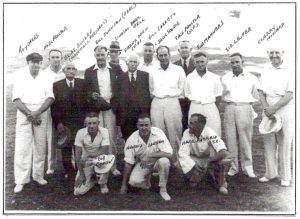
A match between Past and Present players was organised for March 29, 1941 at Lorn Park.
The Past team was captained by Will Johnston and included Jack Scobie, Herb Patfield Senior, Wilfred Jarrett, Les Manners, Sid Leiper, Noel Proctor, Ray Oakes, Lindsay Bell, Bob Conlin, Harold Lanham and Clarry Howard. One disappointment was that the great all-rounder, Gordon Bell, was unable to return to Maitland for the match. However, he did come back to play in another Reunion match held four years later.
The Present team was captained by Col Johnston and included Ken Smith, Alan Johnston, Jack Drane, Norm Mudd, Hugh Norrie, Jim Lindsay, Norm Dolman, Athel D’Ombrain, Harry Kerrigan and Clem Hingston.
The Past hit up 187 with Wilfred Jarrett still showing some of his old form in top-scoring with 63 in an innings that included four sixes and four fours. ln reply after an opening partnership of 85 by Col Johnston and Ken Smith, the Present scored 221.
The “Mercury” reported that “there was delightful batting on both sides with 440 runs scored in 200 minutes. The fielding of the old-timers was described as surprisingly good but lack of condition told in the bowling”.
Present for the Reunion were some of those who had been associated with the early pre-World War 1 years of the Club. Among these were Elias Bowden, Frank Drew, Jack Scobie, Felton Norrie, Jack Proctor, Will and Harold Johnston.
The match was followed on the Saturday night by a dinner at the Imperial Hotel where several toasts were honoured. The President, Will Johnston, congratulated the present members. “on the spirit in which they played the game, and what they were doing to uphold the traditions of Northern Division”.Les Manners presented the “Pop-eye Shield” to Col Johnston, the captain of the winning present team, but said that the Past would take it from them next year. Wilfred Jarrett was presented with the “Epsom Bowl”, the trophy for the highest scorer.
The “Mercury” reported that in all respects the Reunion was “a particularly happy day and that the reminiscences indulged in were not the least pleasant part of the function”.
A Celebrated Coach
For two seasons from 1933-35, Northern Division Club enlisted the services of Halford Hooker as coach. Hooker was a former State player who had represented NSW in Shield and International matches from 1924-32.
In the 1928-29 season, he was associated with Alan Kippax in a world record tenth wicket partnership of 307 against Victoria.
In a return match, he took four wickets in four balls – a record that still stands in Shield cricket. In Sydney grade cricket he played with the Mosman.
In August 1931 Hooker came to Newcastle where he opened a sports store and later became a well-known sports broadcaster with 2NC.
His association with Northern Division Club as coach seems to have followed on from an interesting talk on cricket that he gave to members of the Club in Johnston’s Chambers in October 1933. In seconding a vote of thanks, Mr Jack Reeves “hoped that Mr Hooker would come up again shortly to see if the players had been able to put the good advice given to practical use”. Hooker accepted the invitation.
A Long Term Scorer
Harold Lanham was a long-serving scorer with Northern Division A grade team during the nineteen twenties and thirties. A number of Annual Reports paid tribute to his valuable services. For example, the 1937-38 Report noted that “Mr H.Lanham has now been with the Club longer than any of the present A grade team and we trust that we will continue to merit this gentleman’s continued support. We could ill-afford to lose him”. After the war, he continued links with the Club as Vice President from 1952 – 63.
Back (Left to Right): Col Johnston, Alan Johnston, Jim Lindsay, Roy Bubb (Captain), Norm Dolman, Hugh Norrie, Norm Mudd
Front (Left to Right): Ken Smith, Don Moore, Peter Keene, Athel D’Ombrain
Suspension of Competition
During the 1940-41 season, it became increasingly apparent that it would be difficult for the local competition to continue under war-time conditions. Military enlistments, the draft call up for compulsory training for home defence, petrol rationing and the difficulty of obtaining leave from local army training camps made it hard for clubs to field teams on a regular basis.
At Northern Division’s 1941 Annual Meeting the President, Will Johnston, reported that “military duties affected the majority of the players and the constant changing of the teams selected was unavoidable”. Reference was made to Dick Holmes who, it was believed, was a prisoner-of-war from the campaign in Greece and the meeting decided to forward a Christmas hamper to him. lt was also reported that another member of the A grade team, Max Hopkins, had enlisted and was serving with the RAAF.
The 1941-42 season did get underway but after the Japanese attack on Pearl Harbour on December 7, 1941, the Association’s competitions were abandoned at the Christmas break.
The War Years
Although the local Association went into recess for the remainder of the war period, the first-grade clubs combined to enter teams in the Newcastle competition. These teams were organised by the Maitland District Cricket Club that was formed in 1942.
The Maitland teams included a number of cricketers who played with the Northern Division Club either before or after the war. Among these were Herb Patfield Junior, Athel D’Ombrain, Noel Proctor, Jim Lindsay, Jack Mitchell, Norrn Mudd, Colin Johnston, Alan Johnston, Bob Brown, Norm Robards and Brian Price.
These were later joined in the 1945-46 season by Ken Smith, Norm Dolman, Hugh Norrie and Eddie Hill following their discharge from the Army.
The Maitland Club used Lorn Park as its home ground. This was fortunate for the local Club as it meant that the ground was kept in reasonable condition during the war years while most other grounds in the district suffered from lack of maintenance and deteriorated to a deplorable condition with grass and weeds up to two feet high.
The home games of the “Lucerne Lumpers” (as the Maitland team was often referred to in the press) attracted a strong following of local supporters “despite the primitive accommodation and limited facilities for seating and general comfort”.
Norm Mudds Motor Mower
A common complaint in the years prior to 1943 was about the heavy growth of grass on Lorn Park which reduced the scoring value of shots played along the ground.
In 1942-43 it was reported that Norm Mudd was constructing a motor mower with a four-foot cut and the comment was made: “To those members who followed the small mower seemingly interminable distances, the coming of the new mower is awaited with a silent prayer.”
Norm’s mower, powered by an old Essex motorcar and constructed from scratch, came into use in the 1943-44 season and was of great benefit in improving outfield conditions. The 1943-44 Annual Report of the Maitland District Cricket Club paid the following tribute to Norm and his mower: “Lorn Park was again the Club’s home ground and was generally kept in very fair condition. That the ground was always fast was due to the fact that the motor mower constructed by club members during the off-season functioned right up to expectations and whereas the ground was previously mown about once a season, it was mown nearly every week. Consequently, the ground kept improving and will continue to do so, to the undoubted gratification of both players and spectators. The more the mower is used, the more we realise what the club owes to Norman Mudd who was the guiding light in its construction.”
Dave Rutherford later recalled: “As a young boy, I can still remember seeing some of the present cricketers of that time learning to drive while driving this mower around Lorn Park at between 20-30 miles an hour.”
In addition to the mower, Norm was also mainly responsible for the construction of a sightscreen at the Oval in 1941 – a project that had been mooted many years earlier.
The Maitland teams enjoyed considerable success in the Newcastle competition. Their best season was in 1943-44 when they won the first and third-grade premierships, the club championship and all three finals.
The Chegwyn Matches
Lorn Park during the mid-forties was to be the venue for what became known as the “Chegwyn matches”.
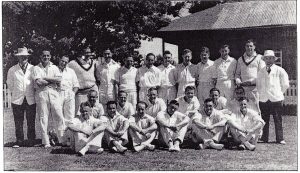
Middle (Left to Right): W. Walmsley, R. Macmillan, F. Coffey, A. Johnston, K. Hill, J. Chegwyn
Front (Left to Right): L. Mannix, R. Camps, N. Robards, J. Leacy, M. Hinman, M. Gill
Jack Chegwyn played for the State in 1941-42 and later became a State Selector who for forty years took star-studded teams into “the bush” to promote country cricket, to spot new talent and to give country people the opportunity of seeing past and present State and international players in action.
The first Chegwyn match in Maitland was to be played at Lorn Park in February 1945. However, there was much controversy when the Council, following a deputation from the Ministers’ Fraternal, refused permission for the fixture to be held on a Sunday. As a result, the match had to be transferred to Cessnock.
A second Chegwyn match was arranged for the 1945-46 pre-season and was played at Lorn Park on Saturday, September 22. The Chegwyn team included Bill O’Reilly, Sid Barnes and Ron Saggers while the Maitland team had two Northern Division players, Norm Mudd and Col Johnston who scored an impressive 95.
Chegwyn made a third visit to Maitland in the 1946-47 pre-season and played two one day matches at Lorn Park on September 21 and 22. His team again included some top players – Arthur Morris, Sid Barnes, Ernie Toshack and Bob Cristofani – while the Maitland teams included the Johnston brothers, Colin and Alan, Norm Robards and Ken Smith.
In the fifties and sixties, Chegwyn was to return for further matches at Lorn Park.
A Brief Revival
The Association was re-formed at the start of the 1945-46 season and conducted All-age and Under 21 Junior competitions for the local players, while the Maitland Club was given permission to enter first and second-grade teams in the Newcastle competition.
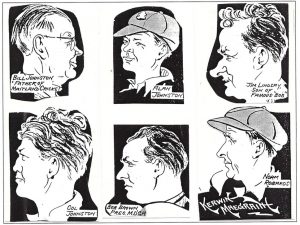
However, the Northern Division Club was not revived until the following season when the Association reintroduced local competitions for A, Band C grades. A Club meeting held on August 16, 1946, at Johnston’s Boot Store elected Will Johnston as President, Ken Smith as Secretary and Max Hopkins as Treasurer.
At the request of the Association to overcome a bye the newly re-formed Club entered two teams in the A grade and one in the C grade, rather than A, Band C grades. Although the Club was weakened by a number of its leading players, including Col Johnston, playing with the Association team in the Newcastle competition, the A grade No.1 team was successful in winning the premiership and the final – a feat that the Club had not achieved since 1932. The win in the final against East Maitland was particularly meritorious as Northern was behind after the first innings.
The Club’s revival was to be short-lived, for 1946-47 was to mark its last season under the name of Northern Division and the end of an era. The final Annual Report noted that “with the almost certain introduction of district cricket next season … the NDCC as it is constituted at present may go out of existence … Formed in 1903, the Club is one of the oldest in the country and has a record second-ta-none in the annals of the HRDCA competitions. Thus, it will be a pity to see it cease to exist altogether, but even if the name has to be changed, some arrangements should be possible whereby the traditions of the club can be perpetuated.”
Roy Oakes
Roy C. Oakes was the son of C.W. Oakes, the Chief Secretary of NSW. He started playing A grade ‘with Northern Division in 1921-22 and for the next fourteen seasons was to be the mainstay of their team.
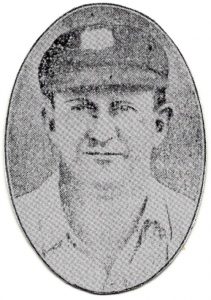
A strongly built cricketer, Roy was a leading all-rounder for the Club and District. In the 1923-24 season, he was awarded a gold medal donated by R.Moncrieff for the best all-round player in the Association.
In the four seasons from 1923-27, he headed the Club’s bowling aggregate with a combined total of 246 wickets, including 82 at an average of 10.96 in the 1924-25 season.
By 1931-32 he was still heading the Club’s batting and bowling averages.
During his playing career with Northern Division, he recorded a number of outstanding performances with bat and ball. In one match against Branxton on October 7, 1922, he scored a century in 61 minutes, hitting seven sixes and thirteen fours. In another match against Morpeth (date unknown) when 34 runs were needed by Northern in seven minutes, the runs were made with Roy scoring 33 of them.
On February 25, 1928 he took 6 wickets for 4 runs when Marist Brothers were dismissed for 12 runs in their, second innings. In the Final of the 1930-31 season against Branxton in a match-winning effort he took 7 for 34 off 12 overs.
Ray was the A grade captain during the period from 1929-32 when the team won three successive Premierships and Finals, and undoubtedly his all-round ability and leadership were a large part of that success.
In representative cricket he was selected to play for Northern District teams against three touring teams – against Gilligan’s M.C.C. team in Maitland in 1925; against Chapman’s M.C.C. team in Newcastle in 1928; and against Cameron’s South African team in Newcastle in 1931. He also captained the Northern District team that played a match in Maitland in 1930 against Alan Kippax’s NSW Sheffield team on its way back from Queensland. During the 1935-36 season, Roy left the district to take up residence in Newcastle. To mark his services to the Club he was presented with an inscribed cigarette case at the Annual General Meeting.
Wilfred Jarrett
Wilfred Jarrett started his cricketing career playing for Eccleston, a small country town on the Allyn River near Gresford. He was one of the invited players for the match against Macartney’s team in 1922 and first appears in the local Association’s averages for 1925-26 as scoring 318 runs at an average of 31.8 and taking 19 wickets at 13.9 for Northern Division.
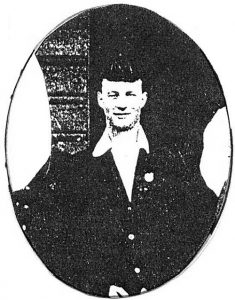
A dashing cricketer, Wilfred was a top all-rounder who was noted for his big-hitting. A Maitland Mercury columnist who wrote under the nom-de-plume “Hillite” gave the following description of his batting:
“One of the most entertaining batsmen in the district, from the public’s point of view, this hard-hitting, rather unorthodox player, has been the worry of many an opposing team. Nearly all his runs come from forceful drives or terrific pulls, and as this is his natural game, his defence is in his attack. He is decidedly weak in back play and is more likely to get out when playing carefully than when playing his usual aggressive innings.”
During the 1931-32 season, he scored one of the quickest centuries in the history of the Association. Playing in a match against Branxton at the West Maitland Showground, he scored a hurricane century in just 37 minutes. His innings of 134 not out included 11 sixes and 10 fours. The “Mercury” reporter noted: “W.Jarrett gave a great display of hitting which was thoroughly enjoyed by the spectators. It was one of the most dashing displays seen in Maitland for a considerable time.”
In another match against Greta United at Lorn Park in the 1932-33 season when he scored 137 not out in 69 minutes, it was reported that the umpire held an extra ball in reserve as Wilfred was continually hitting sixes into the nearby lucerne paddock and too much time was being lost searching for the ball.
“An Old Team Mate” later recalled: “Knocking bowlers out of the ground was something that gave him pleasure and an even greater pleasure to the spectators. Many will remember how he could land them over into Warrane Street and near the old Fire Station in Melrose Street before the Lorn Oval was moved to its present position.”
In the 1926-27 season he figured in two record partnerships for the Club – a sixth wicket partnership of 178 at Lorn Park against Marists on October 9, 1926, with Clem McArthur when he scored 140; and shortly afterwards a fourth wicket partnership of 165 at Lorn against Morpeth on November 20, 1926 with Arthur Watson when he scored 109.
His best season with the bat was in 1932-33 when he scored 582 runs at an average of 64.6 to head the Club’s batting average and aggregate and the District’s batting averages.
As a bowler, Wilfred was described in 1932 by “Hillite” as”probably the most consistent medium pace bowler in the district…He has very little body turn and therefore gets most of his pace off the pitch from arm and wrist action. Only taking a short run, he can bowl for very long periods without a change, and still end up with as much fire in his bowling as when he started”. One of his best seasons in bowling was 1930-31 when he took 38 wickets at an average of 1 0.1.
Wilfred was a regular John Bull Shield representative for the local Association. In 1926-27 he was a member of the Northern District team that won the Iredale Shield at Country Week and in 1933-34 captained the Hunter River team in the Northern Country Week Carnival that was hosted by Maitland. He was also captain of the Hunter River DCA side that played against Alan Kippax’s NSWCA X1 at the Maitland Showground in the 1928-29 season.
By the 1938-39 season, he had moved down from A grade to captain the Club’s B grade team. He still showed good form scoring 304 runs, including a century, and taking 13 wickets. The 1946-47 Annual Report recorded that “Jarrett, the star of former days, was induced to play” in the No.2 A Grade team when the Club was re-formed after World War 2, and in 1947-48 he was back playing second grade.
He continued to remain closely involved with the Club for another ten years as a member of the selection committee and in recognition of his long service extending over thirty years he was made a Life Member of the Club.
Gorden Bell
Gordon R.Bell has been described as “one of the greatest all-rounders ever to be seen in Maitland Cricket”.
He came to Northern Division Club in 1928 after having previously played with Morpeth Club since 1921. He was to play three seasons with Northern from 1928-31.
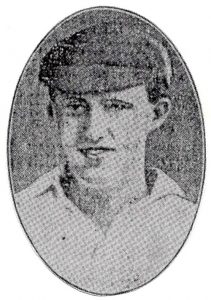
By 1928 he had already built up a formidable reputation as an outstanding cricketer. In the 1924-25 season, for instance, he was awarded a special trophy for scoring 1180 runs (including 838 in Association representative matches) during the season.
In the same season, he had scored 215 not out in a John Bull Shield match against Upper Hunter at Maitland Showground.
His powerhouse display of big-hitting included 10 sixes and 20 fours and his double century was posted in 115 minutes.
After coming to Northern Division, he continued to show great form both with bat and ball. ln 1928-29 he headed the Club’s batting and bowling averages; in 1929-30 he scored 715 runs at an average of 71.5 (wickets unknown); and in 1930-31 with 569 runs (40.6 average) and 51 wickets (7.2 average) he achieved the distinction of being the first player in the history of the Association to achieve the double of scoring 500 runs and taking 50 wickets in a season.
In the Final of the 1929-30 season against Branxton, he also scored a century, so it was not surprising that the Club’s Annual Report for that season referred to “Mr Bell’s performance as wonderful” and as being “a big factor in the success of the first-grade team”.
“Hillite” in 1932 gave the following description of his batting style: “As a batsman, he possesses a powerful cover drive from which he gets the greater part of his runs … he does not exploit behind the wicket shots on the off but executes some delightful leg glances. Bell is severe on anything loose on the leg side particularly. When set, he delights the crowd with his powerful hitting.” “Hillite” also referred to him as “the idol of the cricketing public for many seasons” and as “the prince of good sports” with “his genial disposition endearing him to the public, from the schoolboy to the veteran”.
A well-built six-footer, Gordon was a fast-medium pace bowler. A contemporary, Lin Agnew, later described his action as being “in sharp contrast to that of most present-day bowlers of his type” in that “he took only a shuffling four or five steps before delivery” and developed surprising pace off the pitch.
Prior to coming to Northern Division, he had already represented Combined Country No 2 after his Country Week performances in the early 1920s. He had also played for Northern District teams against Gilligan’s MCC team in 1925, and against a touring NZ team in 1926.
During his stint with Northern Division, he was selected to play for the NSW Country team against the West Indies in Newcastle in January 1931. However, his greatest “moment of local fame” came when he dismissed Don Bradman for a “duck” in a match against an NSWCA X1 at the Maitland Showground on April 1, 1929. With a crowd estimated at about 4000 eagerly looking forward to the prospect of seeing “the Don” in action, Bell had him adjudged leg before for a “duck” in his first over. The umpire, Peter Bailey, when chided later by some of the spectators for giving the LBW decision against Bradman, is reported to have said: “If he was Jesus Christ himself, I’d still have given him out!”
In the 1930-31 season, Bell was also selected in a Northern District team to play against Alan Kippax’s NSW Sheffield Shield team. In the second innings of the match, he delighted the crowd with a hard-hitting 75 that included 8 sixes and 5 fours scored in 34 minutes. He was reported as “creating a sensation” by hitting Stan McCabe for three sixes in his first over.
After returning to his old Club, Morpeth, for two seasons (1931-33) he moved to Sydney to play with Randwick in 1934-35.
After Gordon died in Sydney at the age of 73, Athel D’Ombrain, a fellow player, paid the following tribute to him: “He loved every part of cricket and got great enjoyment from whatever he did either in fielding, bowling or batting. But above all the game itself was what counted most to him and nobody ever played it in a more sporting manner. While nobody played the game more fiercely, a more worthy ambassador to this great sport would be hard to find than this quiet-spoken sporting gentleman who gave so much to uphold the traditions of the great game of cricket in the Hunter Valley.”
Herb Patfield Junior
Herb R. Patfield Junior started playing A grade for Northern Division in 1930-31 at the age of 17. For a few seasons, he played alongside his father, Herb snr. who had been the team’s wicketkeeper from about 1923. To avoid confusion when father and son were both playing in the same team, Herb jnr. was sometimes listed in the scorebook as “J.Patfield” with the “J” referring to “Junior”, so he sometimes became known as “J.Patfield”. To his fellow cricketers, he was commonly known as “Young Pat”.
In his first season (1930-31) with Northern Division, he scored 170 runs and took 17 wickets. ln one match against Branxton he figured in a ninth wicket partnership of 121 with Jack Reeves. The following season the Club’s Annual Report recorded that J.Patfield had the highest score – 13 not out against Robins – and that he was also responsible for the season’s outstanding bowling performances – 7 for 18 against Robins and 8 for 16 against Greta.
By February 1932 he was being described by “Hillite” as “one of, if not, the most promising all-rounder in the Hunter District competitions”. The columnist went on to give the following assessment of his bowling: “As a ‘bosie’ (‘wrong-un’) bowler, his performances are splendid, and with the addition of flight and a little more variation of pace, his deliveries will be even more disconcerting to the opposition. Being tall, he naturally has a high delivery and gains a deal of ‘nip’ from the wicket. His deliveries are rarely loose and this asset, coupled with moderate spin, makes him a bowler of distinct possibilities.”
“Hillite’s” predictions appear to have been justified for Patfield Junior was to have some very successful all-round performances in the thirties. With Northern Division he took 39 wickets and scored 454 runs in 1932-33; 70 wickets and 403 runs in 1933-34; 42 wickets and 317 runs in 1936-37.ln two of those seasons (1933-34 and 1936-37) his figures topped the District bowling aggregate.
In 1934-35 he transferred to the East Maitland Club and then after coming back to Northern Division for two seasons, returned to East Maitland in 1937-38. lt was while he was with East Maitland in 1934-35 that he again headed the District bowling aggregate with 73 wickets at an average of 13.27 and that he created a District record by taking 50 wickets in A grade before Christmas – the only time that this feat has been achieved in the history of the Association.
Patfield Junior represented the Association in John Bull Shield matches and played in a number of Country Week Carnivals. ln November 1935 he was in the Hunter River team that played against Edgar Waddy’s team in a fixture on the Showground as part of the Centenary Celebrations for’ West Maitland. He was also selected as the twelfth man for the Combined NSW Country team that played against Cameron’s South Africans in Newcastle in December 1931. Some local Club followers thought that in the latter case “he should have received better treatment from the selectors”.
In the 1943-44 season, he played second grade with the Maitland Club in the Newcastle competition. He appears to have still had some of his old form for he took 17 wickets during the season and “in an innings reminiscent of his best days” scored 60 in the Final to help give Maitland a win over Waratah. He finished his cricket career playing a few seasons with Raymond Terrace and Hinton after the war.
Athel D’Ombrain
Athel D’Ombrain O.A. is mentioned in the report of the Club’s 1929-30 Annual Meeting. Apparently, this was his first season in A grade and was to mark the beginning of an association with the Club that was to extend over more than fifty years.
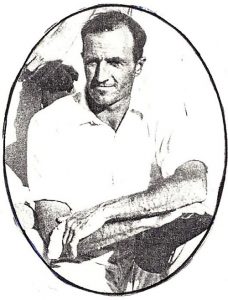
As a cricketer, Athel was noted for his versatility. As “Hillite” summed up this aspect: “I venture to say that A.D’Ombrain of Northern Division, familiarly known to his fellow cricketers as ‘Dorn’, is the most versatile cricketer playing in the HRDC Association competitions
He bowls either fast or slow and is most proficient in either role. As a batsman, he can play the rock with success and then in the same innings turn round and hit the ball as hard and as cleanly as any batsman we have. Some of Dom’s big hits are among the best pieces of work I have seen.”
During his time in the Northern Division A grade team he turned in some very good performances. In the 1930-31 season, he took 20 wickets at an average of 21 and scored 426 runs at an average of 32.7 with a highest score of 98 against Marist Brothers. In the 1934-35 season he topped the Club’s bowling aggregate with 30 wickets and after some lean seasons from 1936-39 came back strongly to take 52 wickets in 1939-40 and 40 in 1940-41.
Athel represented the Hunter River Association on a number of occasions in the John Bull Shield competition and was the twelfth man for the Northern District team for the match against Klppax’s NSW Sheffield Shield team in 1930.
During the war years, he played with the Maitland Club for a couple of seasons in the Newcastle competition – 1942-43 in first grade and 1944-45 in second grade.
In 1946-47 he was back playing in Northern Division’s A grade No.1 team and it was reported that “the veteran of the club, again secured valuable wickets with his leg-spinners and on occasions made handy contributions to the score”.
Athel was particularly active in the administration of the Club. He was Secretary from 1930-36 and after retiring from playing continued his association with the Club conducting Coaching Classes and holding the position of Patron from 1968-87.
He was mainly responsible for organising the 1941 Reunion of the Club and he also took many cricket photos for the Club which were framed and placed in the cricket pavilion. Unfortunately, most of these were lost in the pavilion fire in 1981.
In recognition of his long playing and administrative services, he was made a Life Member of the Club in the early sixties. He was also awarded the Order of Australia for his work as a photographer and naturalist.
Ken Smith
Ken Smith began playing cricket while attending Maitland Technical Primary School. ln 1926 at the age of 13 he was one of Northern Division’s most promising cricketers and moved into A grade in 1930 at the age of 16.
By the 1932-33 season, he was third in both the batting aggregate and averages, scoring 276 runs at an average of 21.3.
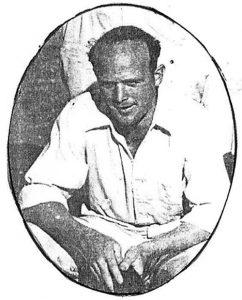
The following season as the opening batsman for the A grade No.2 team he topped the Club’s batting aggregate with 405 runs and had the highest score of 78.
In the 1935-36 season he was reported as scoring a century and following a couple of lean seasons returned to form in 1939-40 and in 1940-41 with 298 runs and 319 respectively.
Apart from his cricketing ability, Ken was a talented Rugby Union player. He was captain of the Maitland Union team which won the premiership in 1937 and also played against the New Zealand All Blacks in 1934, the New Zealand All Maoris team in 1935 and the South African Springboks in 1937.
After the war, Ken was back playing cricket with the re-formed Northern Division Club. He played “up-and-down the grades” until the mid-fifties before retiring, but later made a “comeback” in 1963-64 and as captain of the third-grade team had three successful seasons before once more giving up the game to take up bowls.
During his time with the Club, he was very actively involved in the administration. He was Treasurer for nine years from 1932-41 and the first post-war Secretary in 1946-47. ln recognition of his services he was made a Life Member.
At the end of the 1946-47 season when it appeared as if he would be lost to the Club with the introduction of District cricket, the President Will C.Johnston paid the following tribute to him: “Whatever is the future of the Club, many former N.D.C.C. players will not be eligible to play with the club that will occupy Lorn Park. All will be missed but none more so than Ken Smith. He has been a member of Northern Division for nearly twenty years, and before being the first post-war Hon. Secretary was Hon. Treasurer for nine years. He captained the A grade team on many occasions and was invariably one of our most successful performers. He has only recently left Lorn to start a business on his own account in West Maitland and the club to be formed will miss his services as a player, official and as a most enthusiastic member.”
Hugh Norrie
Hugh Norrie was another prominent player who started his cricket career with Northern Division in the early thirties. The 1932-33 Annual Report recorded that “their new member, H.Norrie, did well” in A Reserve grade and that he was congratulated for the highest individual score (98).
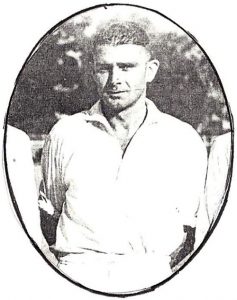
A left-hand batsman and a right-arm fast bowler, Norrie moved into A grade the following season (1933-34) while still at High School. He played in the No.2 team scoring 318 runs and taking 7 wickets and represented Hunter River in John Bull Shield.
The 1934-35 season was his best with the bat, as recorded in the Annual Report: “The highest batting average and aggregate were scored by H.Norrie with an average of 59 and an aggregate of 413. His highest score was 84 and he was five times not out. This was a splendid performance, and as he also topped the average for the district, it was a record to be proud of for his first (second?) season in the A grade.”
In 1935-36 he scored his first century in A grade. ln 1937-38 he won the Club’s batting average with 283 runs at 28.3 and was reported as showing “great improvement as a bowler” in taking 18 wickets at 16.8.
The 1938-39 Annual Report recorded: “H.Norrie fell away in his batting although he averaged over 20. He appears to have gone from the extreme of slogging to the extreme of stone-walling. He would do better if he could return to the safe but aggressive type of play that put him at the head of the Association’s averages with over 50 per innings.”
Like his fellow player, Ken Smith, Hugh Norrie was an outstanding Rugby Union player. He represented Newcastle and NSW Country and played against the touring NZ All Blacks. He later helped to re-form the Maitland Rugby Union Club after World War 2.
After war service in New Guinea, he returned to play first-grade cricket with the Club in 1946-47. The following season he moved down to second grade where he continued to play until 1955. After a season in third grade, he retired in 1956.
